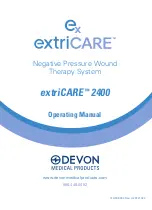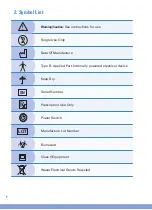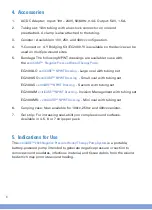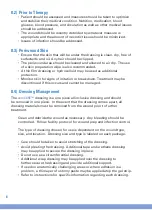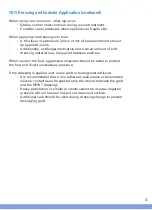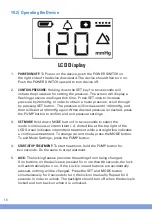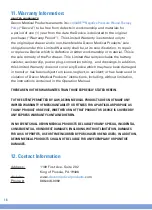
7
8
8.1) Be aware for any of the following conditions (continued):
4.
INFECTION:
Infected wounds and osteomyelitis pose significant
risks for
Negative Pressure Wound Therapy
. If untreated osteomyelitis is
present, therapy should not be initiated. If the wound is infected, it
should be closely monitored and dressings should be changed frequently.
Additionally, to reduce the risk of transmission of infectious agents,
standard precautions should be taken when handling or working with
therapeutic parts or equipment.
5.
PATIENT SIZE AND WEIGHT:
Patient size and weight should be taken
into account when prescribing therapy. In addition, small adults, young
adults or elderly patients should be closely monitored.
6.
SPINAL CORD INJURY:
If a patient experiences autonomic dysreflexia
(sudden changes in blood pressure or heart rate because of sympathetic
nervous system stimulation) discontinue
extriCARE™
therapy to minimize
sensory stimulation and give immediate medical assistance.
7.
MODE:
In unstable anatomical structures, continuous rather than
intermittent therapy is recommended to help minimize movement and
instability. Continuous therapy is also recommended in patients with an
increased bleeding risk, profusely exudating wounds, fresh grafts and/or
flaps, and wounds with acute enteric fistulae.
8.
ENTERIC FISTULAS:
Wounds with enteric fistulas require special
consideration to be effective in negative pressure wound therapy.
If enteric fistula effluent management or containment is the only goal
of such therapy,
extriCARE™
is not recommended.
9.
CIRCUMFERENTIAL DRESSING:
Do not use circumferential dressings.
10.
BRADYCARDIA:
Avoid placement of the
extriCARE™ 2400 Negative Pressure
Wound Therapy Dressings
next to the vagus nerve to minimize the risk of
bradycardia.
NOTE:
If any of this information is not understood, contact the manufacturer before using the
device.
Содержание extriCARE 2400
Страница 24: ...www devonmedicalproducts com 866 446 0092...

